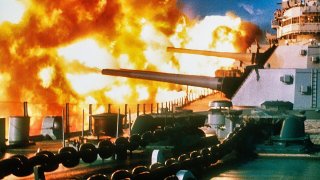The Remarkable Story of How 4 Battleships Attacked North Korea
The U.S. Navy took the Iowa-Class battleships out of a short retirement to attack North Korea during the tragic Korean War during the early 1950s.
The Korean War, when remembered at all, is typically remembered as a land conflict, territorial contest that resulted in the 38th parallel. But the Korean War also featured a naval component. And within the naval component, the Iowa-class battleships featured prominently.
The Iowa-Class battleship
The Iowa Class battleships were ordered in 1939 and 1940, and were designed to intercept fast Japanese vessels (and also serve in a traditional battle line).
Only four Iowa class battleships, the Iowa, New Jersey, Missouri, and Wisconsin were completed (the Illinois and the Kentucky were laid down but scrapped before completion).
The completed Iowa class battleships were 860 feet long at the waterline and displaced roughly 55,000 tons. The ships featured a triple bottom under the armored citadel and armored skegs around the inboard shafts.
The Iowa class was built for speed – but the ship was also stable, making them effective as a gun platform. Additionally, the Iowa was regarded to have excellent maneuverability for its size.
The Iowa featured a long fine bow and a hull that widened suddenly in front of the foremost turret; the result was a very “wet” ship relative to its size that produced intense spray formations.
For armament, the Iowa relied on nine 16-inch 50-caliber Mark 7 naval guns – which were capable of firing high explosive and armor piercing shells as far as 23.4 nautical miles.
Additionally, the Iowa housed six 5-inch/38 caliber Mark 12 guns – capable of firing shells at about 2,5000-2,600 feet per second.
The Iowa-Class Battleships in Korea
The Iowa class battleships had been deactivated after World War II.
But at the commencement of the Korean War, four Iowa class battleships were reactivated: the Iowa, the New Jersey, the Missouri and the Wisconsin.
The Iowa battleships were still in excellent working order and required minimal modifications to be reactivated.
The biggest modification? World War II era floatplanes were replaced with helicopters.
The Iowa class battleships were used to barrage Chinese and North Korean positions along the coast.
Both the sixteen-inch armament and the five-inch armament was used in the effort. In addition to fortified coastal positions, the Iowa class was also used to attack strategic and operational targets (i.e. railways, industrial parks, and transport centers).
Sometimes the targets selected were as far as 20 miles inland from the coast.
The primary danger that the Iowa class faced during the conflict came from mines laid in the Yellow Sea, which restricted the Iowa’s ability to move about.
The Iowa effect
The overall effect of the Iowa battleships on the conflict is difficult to gauge. Communist forces reacted to the presence of the battleships, and moved valuable targets further inland, outside of the range of the Iowa’s heavy guns.
Also, the US relied heavily on aerial bombing – so determining which damage the Iowa class caused, and which damage the US bombers caused, is difficult.
The Navy noted that while the Iowa class performed admirably, the Iowa was not any more effective than the small and cheaper heavy cruisers that the US Navy deployed to perform a similar role.
After the war, the Iowa battleships were reverted back to Reserve status. And while the effectiveness of the Iowa ships is questionable, the presence of the battleships during the conflict left an impression on the North Koreans and the Chinese, who both modified their naval doctrines to account for potential vulnerabilities to battleship bombardment.
About the Author
Harrison Kass is a prolific defense writer with over 1,000 articles published. An attorney, pilot, guitarist, and minor pro hockey player, Harrison joined the US Air Force as a Pilot Trainee but was medically discharged. Harrison holds a BA from Lake Forest College, a JD from the University of Oregon, and an MA from New York University. Harrison listens to Dokken.


